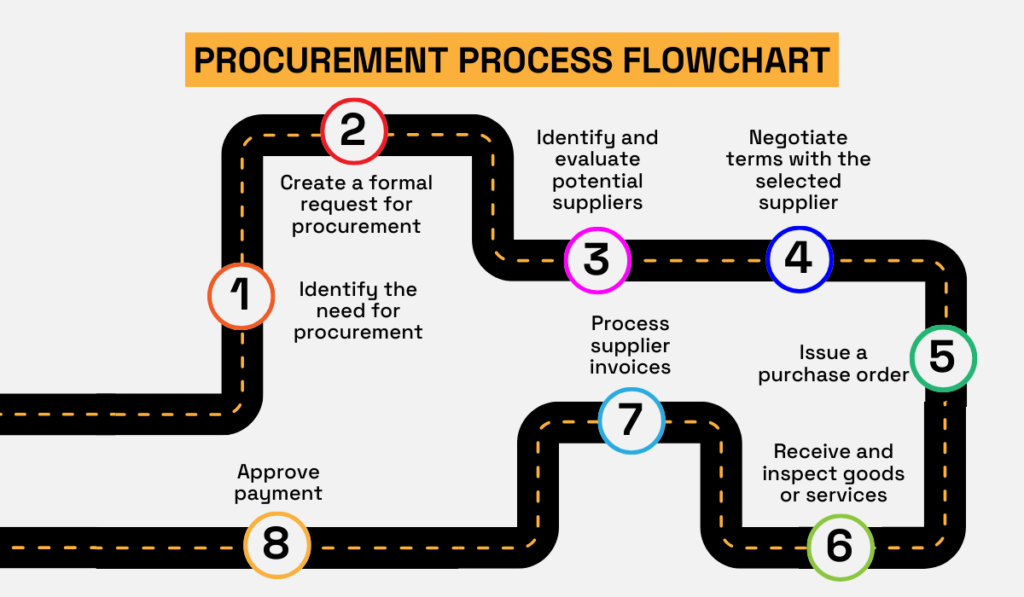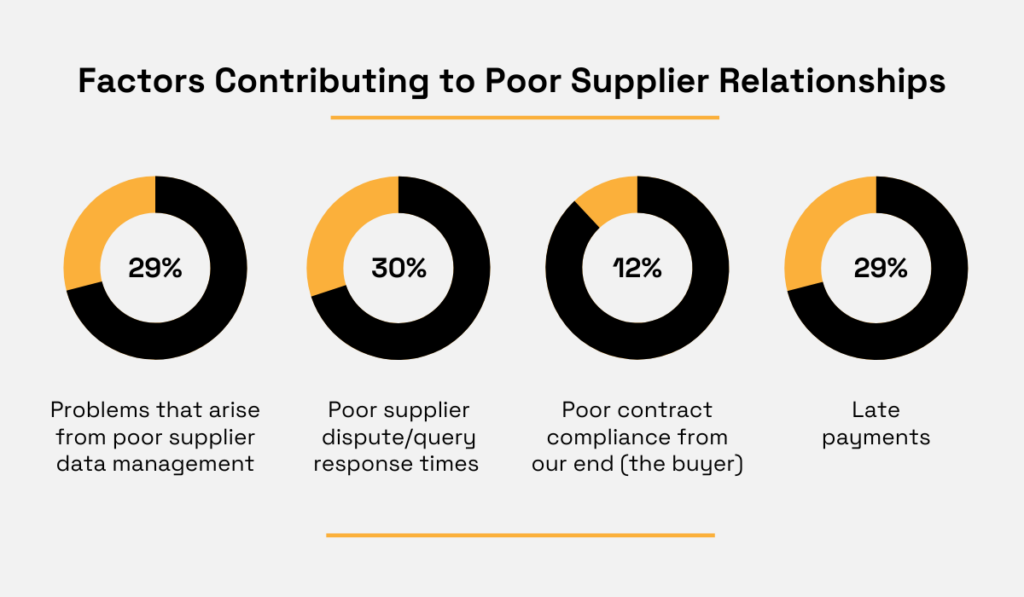How to Boost Your Procurement Performance


The success of your company largely depends on how efficiently it sources raw materials, components, and other goods that make your final product or support your business functions.
This entails effective supplier sourcing, contract negotiation, risk mitigation, and relationship management, all of which can significantly impact your company’s bottom line and competitive advantage.
So, how can you boost your procurement performance?
In this article, we’ll explore six effective ways to do so, from establishing clear procurement policies to leveraging data and technology and cultivating strong supplier relationships guided by indicative KPIs.
Clear procurement policies and procedures are essential for organizations to ensure transparency, efficiency, and compliance in their purchasing activities.
When a company is starting out, it might think there’s no need to establish an official procurement policy.
However, as the company grows and its procurement needs become more complex, the lack of formal policies can lead to maverick spending, compliance issues, increased risks, and inefficiencies in supplier management.
Conversely, with clear procurement procedures in place, these issues can be avoided or minimized as employees can reference what steps to follow when sourcing goods and services.

Source: Veridion
By including detailed descriptions and requirements to be met during these steps in the procurement policy, companies can effectively communicate expectations and procedures to employees, suppliers, and other stakeholders involved in the procurement process.
Additionally, the policy serves as a reference point for addressing questions, resolving disputes, and ensuring accountability in procurement activities.
So, how do you ensure your procurement policy and related procedures are clear and effective?
Here are some general writing tips, courtesy of Tom Rogers from Vendor Centric:

Illustration: Veridion / Data: Vendor Centric
For example, organizing the policy’s content logically and using plain language helps avoid employee confusion, while providing examples and using visual aids can enhance their understanding.
Once prepared, you should ensure that the policy and procedures are communicated to all relevant stakeholders, including procurement team members, department heads, and suppliers.
Additionally, remember to treat your procurement policy as a first draft, meaning it should be regularly reviewed and updated based on user feedback.
Otherwise, as digital procurement expert Joël Collin-Demers warns, you’re risking that your policy won’t be of any actual use to your procurement team and other employees.

Source: LinkedIn
Overall, by incorporating detailed descriptions of procurement procedures, adhering to best writing practices, and continuously refining the policy based on feedback, you lay the groundwork for transparent, efficient, and compliant procurement processes.
All the above will result in well-defined procurement policies and procedures, which can be essential for boosting your procurement performance.
In today’s world, we’re faced with more procurement-relevant data than ever before.
Additionally, companies need this data now more than ever.
Why?
Just consider the rapidly evolving procurement landscape reflected in price changes and supply chain disruptions stemming from health and economic crises, natural disasters, and geopolitical conflicts.
Fortunately, procurement data is also more accessible than at any time in history.
Therefore, your procurement team should make use of data and leverage data analytics tools to:
What’s more, a range of other benefits are generated by utilizing data collection and analytics tools, often collectively referred to as “big data”.

Source: Veridion
For instance, Amazon is one of the early adopters of big data analytics in procurement.
Among other things, they utilize advanced analytics to:
According to Aranca, a global research and consultancy company, optimizing suppliers’ deliveries to warehouses nearest to their customers allowed Amazon to achieve a 30-40% reduction in shipping costs.
However, not-so-large companies can also use big data to their advantage.
For example, companies can leverage big data platforms, like our Veridion, to conduct real-time market research and easily find the best suppliers for their procurement needs.

Source: Veridion
Veridion uses AI-driven machine learning algorithms to scour billions of web pages on a weekly basis and provide companies with the most up-to-date supplier information.
Using its advanced search functions, you can identify and assess potential suppliers according to any criteria, from specifics of their products to their capacity, past performance, and industry certifications.

Source: Veridion
Moreover, your search for prospective suppliers is done in seconds, while the provided data reliability scores also minimize the time required for supplier evaluation.
Veridion’s Drew Doherty explains in a video demonstrating a pharmaceutical company’s search for a specific chemical compound:

Source: Veridion
This quote exemplifies the power of using big data in streamlining procurement operations.
According to McKinsey, such tools allow companies to minimize the time needed to find the right suppliers by as much as 90%.
To recap, leveraging big data presents unparalleled opportunities for companies to gain data-driven insights and make informed procurement decisions.
This allows them to enhance their procurement performance and maintain competitiveness in today’s dynamic business environment.
In your pursuit of improved procurement performance, leveraging technology is intrinsically linked with making use of data.
This primarily entails electronic procurement systems, often in the form of cloud-based software, which automate and streamline procurement processes.
These sophisticated systems offer an array of features and capabilities designed to enhance efficiency, minimize manual errors, and provide real-time visibility into procurement activities.
Naturally, the market offers numerous such solutions, some of which you can explore in our article about top procurement automation tools.
On that note, we’ll use just one example to illustrate what these tools can do to boost your procurement performance.
Tradogram is a cloud-based procurement management solution that offers a range of features designed to enhance procurement performance.

Source: Tradogram
For instance, its procure-to-pay component streamlines the entire purchasing process from procurement to payment, ensuring seamless transactions and efficient financial management.
Furthermore, its strategic sourcing features empower users to, for example:
Additionally, its supplier management capabilities enable you to monitor supplier performance, facilitate communication, and access comprehensive supplier information effortlessly.
Moreover, you can easily integrate it with other tools, like the big data platforms we mentioned, to streamline supplier discovery and analyze supplier performance.
This single example demonstrates the transformative potential of leveraging technology in enhancing procurement performance, from optimizing purchasing processes to harnessing data-driven insights for informed decision-making.
Maintaining strong supplier relationships is paramount for optimizing procurement performance and ensuring a stable and reliable supply chain.
By prioritizing relationships with key suppliers, your procurement team can foster collaboration, drive innovation, and mitigate risks effectively.
In doing so, monitoring and regularly assessing supplier performance is essential, as it enables your team to identify areas for improvement and address any challenges proactively.
Moreover, collaborating with suppliers to streamline processes and reduce costs can lead to mutual benefits and long-term success.
On the flip side, supplier relationships are often negatively affected by poor supplier data management, inadequate dispute resolution mechanisms, and delayed payments.
In a survey by Paystream Advisors, companies were asked what the top contributors to poor supplier relationships were.
You can see the results below.

Illustration: Veridion / Data: SoftCo
These issues can strain relationships, disrupt supply chains, and ultimately impact your business operations and profitability.
Therefore, investing in robust supplier management practices is crucial for maintaining healthy and productive partnerships.
One effective way to cultivate supplier relationships is by implementing transparent communication channels and establishing clear expectations regarding performance, quality standards, and delivery timelines.
Simply put, there is no substitute for open and honest communication, which fosters trust and ensures that both your organization and its suppliers are aligned in their objectives and commitments.
As mentioned, you can also leverage technology solutions to enhance supplier relationship management processes.
The solution below—and other similar advanced supplier management software—can streamline communication, facilitate performance tracking, and provide actionable insights for continuous improvement of supplier relationships.

Source: Kodiak Hub
To recap, by using the right methods and tools, your organization can cultivate strong and mutually beneficial supplier relationships, thus improving your procurement performance.
Having robust risk management policies is crucial for safeguarding supply chain operations and ensuring smooth procurement performance.
More specifically, by proactively identifying and mitigating potential supplier risks, you can effectively protect your organization from various disruptions, such as:
For effective risk management, you need to collect, monitor, and analyze supplier data across a range of parameters, some of which are shown here.

Source: Veridion
Keeping a close watch on these parameters can allow your procurement team to evaluate the overall risk associated with each supplier, both during their selection and throughout your relationship.
Furthermore, this allows you to establish risk management policies with clear provisions about contingency plans required to address any supply chain disruptions that may arise.
To vet your potential suppliers and monitor your existing ones against risks, you can again leverage real-time data and analytics provided by Veridion.

Source: Veridion
By receiving fresh data on any issues your suppliers might be facing, from financial difficulties to geopolitical tensions in their region, you can quickly and easily assess potential risks and take appropriate actions.
Moreover, you can create custom risk factors and instruct Veridion to monitor them and provide real-time alerts should they appear.
In summary, implementing strong risk management policies supported by the right risk monitoring tools enables your organization to mitigate risks effectively, develop contingency plans, and maintain the resilience of its supply chain in the face of uncertainties.
Defining and tracking Key Performance Indicators (KPIs) is essential for evaluating the effectiveness of your procurement process.
More specifically, these supplier management metrics serve as benchmarks for measuring their performance and identifying areas for improvement, ultimately enhancing your procurement results.
Moreover, they enable you to identify underperforming suppliers and take corrective actions to maintain a high standard of supplier performance.
Here are some key KPIs you should define, monitor, and assess on a regular basis.

Source: Veridion
For instance, defect rate measures the percentage of defective or non-conforming products received from each supplier.
So, if a supplier consistently delivers components/raw materials with quality defects, this can indicate a need for improvement initiatives or supplier reevaluation.
Similarly, lead time refers to the time it takes for an order to be fulfilled from the moment it’s placed until it’s received.
Monitoring lead times helps ensure timely delivery of goods and identifies inefficiencies in the supply chain.
Of course, there are many more KPIs you can establish and assess, such as a group of so-called cost-saving metrics, which are critical for measuring the financial impact of your procurement initiatives.

Source: Precoro
For example, procurement ROI (Return on Investment) measures the financial return generated from procurement activities relative to the investment made in those activities.
A positive procurement ROI indicates that the value derived from procurement activities related to a specific supplier exceeds the costs incurred.
Another example is spend under management (SUM), which measures the percentage or amount of your company’s total procurement spend that is actively managed or controlled by its procurement function.
Therefore, reducing non-controlled, indirect spend allows procurement teams to leverage their purchasing power, negotiate better terms with suppliers, and implement strategic initiatives to optimize spending and achieve cost savings.
In summary, defining, tracking, and regularly reviewing your KPIs enables you to measure supplier performance, identify opportunities for enhancement, and drive continuous improvement in your procurement processes.
Although there’s a lot to consider, it’s clear that effective practices for boosting your organization’s procurement performance are within your reach.
By implementing robust procurement and risk management policies, leveraging technology, cultivating supplier relationships, and monitoring key performance indicators, your organization can navigate the complexities of procurement with confidence.
With a commitment to continuous improvement and strategic decision-making, you can achieve procurement excellence and help your company maintain a competitive edge in today’s dynamic marketplace.